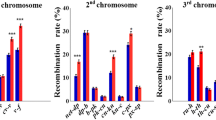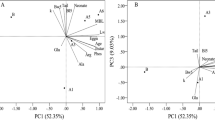Abstract
We isolated and cloned strongly positively and strongly negatively phototactic individuals from a single natural population of Daphnia magna using an experimental column of 2 m high and an irradiance of 2000 W It is argued that the positively phototactic behaviour is genetic, recessive, that the individuals that showed the behaviour were heterozygous, and thus the genetic system probably polygenic. Populations should maintain such genotypes in heterozygous form and in low numbers, in spite of selection against them, because they are their guarantee against extinction, should the pressure of natural selection ever become reversed.
Similar content being viewed by others
References
Banta, A. M., 1939. Studies on the Physiology, Genetics, and Evolution of some Cladocera. Carnegie Inst. Washington Publ. 513: x + 285 pp.
Buchanan, C. & J. F. Haney, 1980. Vertical migration of Zooplankton in the Arctic: A test of the environmental controls. In W. C.Kerfoot (ed.), Evolution and Ecology of Zooplankton Communities. Univ. Press New England: Hanover, pp. 69–79.
Dumont, H. J., 1972. A competition-based approach to the reverse vertical migration in zooplankton and its implications, chiefly based on a study of the interactions of the rotifer Asplanchna priodonta Gosse with several crustacea entomostraca. Int. Revue ges. Hydrobiol. 57: 1–38.
Hairston, N. G. Jr, 1976. Photoprotection by carotenoid pigments in the copepod Diaptomus nevadensis. Proc. nat. Acad. Sci. U.S. 73: 971–974.
Lane, P. A., 1975. The dynamics of aquatic systems: A comparative study of the structure of four zooplankton communities. Ecol. Monogr. 45: 307–336.
Lair, N. & D. Djokosetiyanto, 1984. Observations sur les variations de la pigmentation du Copépode Acanthodiaptomus denticornis (Wierzejski, 1887) en fonction de ses stades de développement, sans liaison avec leur comportement migratoire. C. r. Acad. Sci. Paris, Ser. 3, 298: 291–293.
Ringelberg, J., 1980a. Introductory remarks: Causal and teleological aspects of diurnal vertical migration. In W. C. Kerfoot (ed.), Evolution and Ecology of Zooplankton Communities. Univ. Press New England: Hanover, pp. 65–68.
Ringelberg, J., 1980b. Aspects of red pigmentation in zooplankton, especially Copepods. In W. C. Kerfoot (ed.), Evolution and Ecology of Zooplankton Communities. Univ. Press New England: Hanover, pp. 91–97.
Stich, H. B. & W. Lampert, 1981. Predator evasion as an explanation of diurnal vertical migration by zooplankton. Nature 293: 396–398.
Weider, L. J., 1984. Spatial heterogeneity of Daphnia genotypes: Vertical migration and habitat partitioning. Limnol. Oceanogr. 29: 225–235.
Zaret, T. M. & J. S. Suffern, 1976. Vertical migration in zooplankton as a predator avoidance mechanism. Limnol. Oceanogr. 21: 804–813.
Author information
Authors and Affiliations
Rights and permissions
About this article
Cite this article
Dumont, H.J., Guisez, Y., Carels, I. et al. Experimental isolation of positively and negatively phototactic phenotypes from a natural population of Daphnia magna Strauss: A contribution to the genetics of vertical migration. Hydrobiologia 126, 121–127 (1985). https://doi.org/10.1007/BF00008678
Received:
Accepted:
Published:
Issue Date:
DOI: https://doi.org/10.1007/BF00008678




